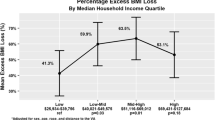Abstract
Introduction
Successful weight loss after laparoscopic Roux-Y gastric bypass (LRYGB) hinges on many elements including neurohormonal, anatomical, and postoperative behavioral changes. To date, the effects of socioeconomic factors have been inadequately studied. We examine several components of socioeconomic status and its relationship to weight loss after LRYGB.
Methods
Between August 2002 and July 2006, 405 LRYGB were performed by a single surgeon. Patient demographics were entered into a longitudinal, prospective database. At 1-year follow-up, 309 patients were available for analysis. Regional median household income (RMAHI) and primary insurance carrier were used as surrogates for preoperative socioeconomic status. Analysis of covariance (ANCOVA) test was used for statistical analysis. According to RMAHI, we divided the patients into three groups: US $20,001–40,000 (group A, n = 67), US $40,001–60,000 (group B, n = 153), and more than US $60,000 (group C, n = 89). Initial body mass index (BMI) was 52.76 ± 1.01, 51.28 ± 0.67, and 48.87 ± 0.94 kg/m2, respectively. Additionally, patients were divided according to private insurance or state-based insurance. A total of 274 patients had private insurance, with an initial mean BMI of 50.6 kg/m2, and 35 patients had state-based insurance, with an initial BMI of 53.0 kg/m2.
Results
After 1 year, weight loss in groups A, B and C was 110.6 ± 4.3, 110.0 ± 2.5, and 103.9 ± 3.6 lb with BMI decrease of 17.7 ± 0.6, 17.7 ± 0.4, and 16.9 ± 0.6 kg/m2, respectively. Weight loss in the private insurance group was 49.2 ± 0.9 kg compared with 50.2 ± 2.3 kg in the state-based group with BMI decrease of 17.4 ± 0.3 and 18.4 ± 0.8 kg/m2, respectively. There were no statistical significances in the effect of socioeconomic status, median household income, and insurance carrier on postoperative weight loss.
Conclusion
With appropriate patient selection, the socioeconomic status of patients undergoing LRYGB does not affect postoperative weight loss.


Similar content being viewed by others
References
Mason EE, Tang S, Renquist KE (1997) A decade of change in surgical obesity. National Bariatric Surgery Registry (NBSR) contributors. Obes Surg 7:189–197
Anonymous (2004) The ASBS consensus conference on the state of morbid obesity; health implications for patients, health professionals and third-party payers. ASBS Consensus Conference, Georgetown University, Washington, DC
Schirmer B (2006) Laparoscopic bariatric surgery. Surg Endosc 20(Suppl 2):S450-S455. Epub 2006 Mar 16. Review
Benotti PN, Forse RA (1995) The role of gastric surgery in the multidisciplinary management of severe obesity. Am J Surg 169:361–367
Hsu LK, Benotti PN, Dwyer J (1998) Nonsurgical factors that influence the outcome of bariatric surgery: a review. Psychosom Med 60:338–346
US Census Bureau (http://factfinder.census.gov/home/saff/main.html?_lang=en). Accessed 11 September 2008
Martin L, Tan T, Holmes P et al (1991) Preoperative insurance status influences postoperative complication rates of gastric bypass. Am J Surg 161(6):625–634
Melton G, Steele K, Schweitzer M et al (2008) Suboptimal weight loss after gastric bypass surgery: correlation of demographics, comorbidities, and insurance status with outcomes. J Gastrointest Surg 12:250–255
Lutfi R, Torquati A, Sekhar N et al (2006) Predictors of success after laparoscopic gastric bypass: a multivariate analysis of socioeconomic factors. Surg Endosc 20:864–867
Harvin G, Delegge M, Garrow D (2008) The impact of race on weight loss after Roux-en-Y gastric bypass surgery. Obes Surg 18:39–42
Capella R, Capella J (1993) Ethnicity, type of obesity surgery and weight loss. Obes Surg 3:375–380
Buffington C, Marema R (2006) Ethnic differences in obesity and surgical weight loss between African-American and Caucasian females. Obes Surg 16:159–165
Sanchez-Cabezudo Diaz-Guerra C, Larrad Jimenez A (2002) Analysis of weight loss with the biliopancreatic diversion of Larrad: absolute failures or relative successes? Obes Surg 12(2):249–252
Hafner R, Rogers J, Watts J (1990) Psychological status before and after gastric restriction as predictors of weight loss in the morbidly obese. J Psychosom Res 34:295–302
Stunkard A, Stinnett J, Smoller J (1986) Psychological and social aspects of the surgical treatment of obesity. Am J Psychiatry 143(4):417–429
Margo D, Geloneze B, Delfini R et al (2008) Long-term weight regain after gastric bypass: a 5-year prospective study. Obes Surg 18(6):648–651
Saunders R (1999) Binge eating in gastric bypass patients before surgery. Obes Surg 9:72–76
Author information
Authors and Affiliations
Corresponding author
Rights and permissions
About this article
Cite this article
Akkary, E., Nerlinger, A., Yu, S. et al. Socioeconomic predictors of weight loss after laparoscopic Roux-Y gastric bypass. Surg Endosc 23, 1246–1251 (2009). https://doi.org/10.1007/s00464-008-0138-z
Received:
Revised:
Accepted:
Published:
Issue Date:
DOI: https://doi.org/10.1007/s00464-008-0138-z




